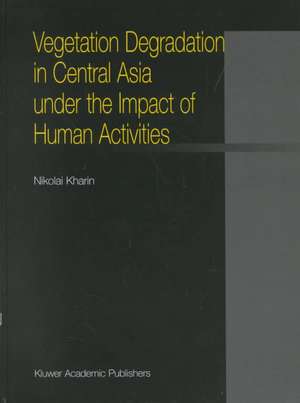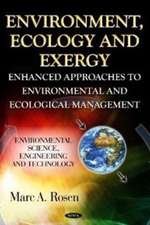Vegetation Degradation in Central Asia under the Impact of Human Activities
Autor N. Kharinen Limba Engleză Hardback – 28 feb 2002
| Toate formatele și edițiile | Preț | Express |
|---|---|---|
| Paperback (1) | 642.36 lei 6-8 săpt. | |
| SPRINGER NETHERLANDS – 17 sep 2012 | 642.36 lei 6-8 săpt. | |
| Hardback (1) | 648.89 lei 6-8 săpt. | |
| SPRINGER NETHERLANDS – 28 feb 2002 | 648.89 lei 6-8 săpt. |
Preț: 648.89 lei
Preț vechi: 763.40 lei
-15% Nou
Puncte Express: 973
Preț estimativ în valută:
124.20€ • 134.96$ • 104.40£
124.20€ • 134.96$ • 104.40£
Carte tipărită la comandă
Livrare economică 21 aprilie-05 mai
Preluare comenzi: 021 569.72.76
Specificații
ISBN-13: 9781402003974
ISBN-10: 1402003978
Pagini: 204
Ilustrații: XVII, 182 p.
Dimensiuni: 210 x 279 x 17 mm
Greutate: 0.65 kg
Ediția:2002
Editura: SPRINGER NETHERLANDS
Colecția Springer
Locul publicării:Dordrecht, Netherlands
ISBN-10: 1402003978
Pagini: 204
Ilustrații: XVII, 182 p.
Dimensiuni: 210 x 279 x 17 mm
Greutate: 0.65 kg
Ediția:2002
Editura: SPRINGER NETHERLANDS
Colecția Springer
Locul publicării:Dordrecht, Netherlands
Public țintă
ResearchCuprins
1.1. United Nations Convention to Combat Desertification (CCD).- 1.2. Global extension of desertification.- 1.3. Change of biological diversity.- 1.4. Degradation of the drylands of Asia.- Physical Environment and Agricultural Development.- 2.1. Introduction.- 2.2. Climate and desertification.- 2.3. Soils.- 2.4. Vegetation.- 2.5. Livestock raizing.- 2.6. Crop production.- 2.7. Pollution of environment.- 2.8. Summary and conclusion.- Historical Interaction of Desert and Society.- 3.1. The first ecological catastrophe in Central Asia.- 3.2. Land use and impact of war during the Middle Ages.- 3.3. Land reclamation, ecology and social life in Russian Turkestan.- 3.4. Aborigines and newcomers in the desert.- 3.5. We shall even control the drought!.- 3.6. Conclusion.- Political, Economic and Social Impact of Land Degradation During the Soviet Period.- 4.1. Large leap — a Central Asian version.- 4.2. Cadre determines all!.- 4.3. Change of social and ecological conditions in rural area.- 4.4. “Pripiska” and its role in land degradation.- 4.5. Conclusion.- Methodology of Desertification Assessment and Mapping.- 5.1. The concept and criteria of assessment.- 5.2. Remote sensing indicators of desertification.- 5.3. Compilation of desertification map of Turkmenistan.- 5.4. Use of NOAA/AVHRR data to study desertification.- 5.5. Multistage desertification monitoring.- 5.6. Conclusion.- Status of Degraded Arid Lands.- 6.1. Change of biodiversity under the impact of desertification.- 6.2. Degradation of forests.- 6.3. Degradation of desert rangelands.- 6.4. Soil degradation.- 6.5. Change of desert environment along the Karakum Canal bordering area.- 6.6. Summary and conclusion.- Change of Wildlife.- 7.1 Animals from “The Red Data Book”.- 7.2 Other species of wildlife standalso in need of protection.- 7.3. Hunting and poaching.- 7.4. Conclusion.- Accumulated Ecological Problems in New Independent Countries of Central Asia After 1991.- 8.1. Sovereignty, poverty and refugees.- 8.2. Scarcity of water resources.- 8.3. Worsening ecological and social conditions in the areas affected by desertification.- 8.4. Enormous economic and social damage caused by desertification.- 8.5. Conclusion.- Convention to Combat Desertification — A Gleam of Hope at the end of the Tunnel.- 9.1. A concept for rehabilitation of degraded desert lands.- 9.2. Regeneration of forests.- 9.3 New approaches and arrangements.- 9.4 National Action Program to Combat Desertification (NAPCD) in Turkmenistan.- 9.5. Creation of enabling environment for implementation of NAPCD.- 9.6. Summary and conclusion.- Synthesis and Conclusion.- 10.1. Lessons of the past.- 10.2. Up-to-date situation.- 10.3. The requirements of future activities in desertification control.- Glossary of Local and Special Terms.- References.











